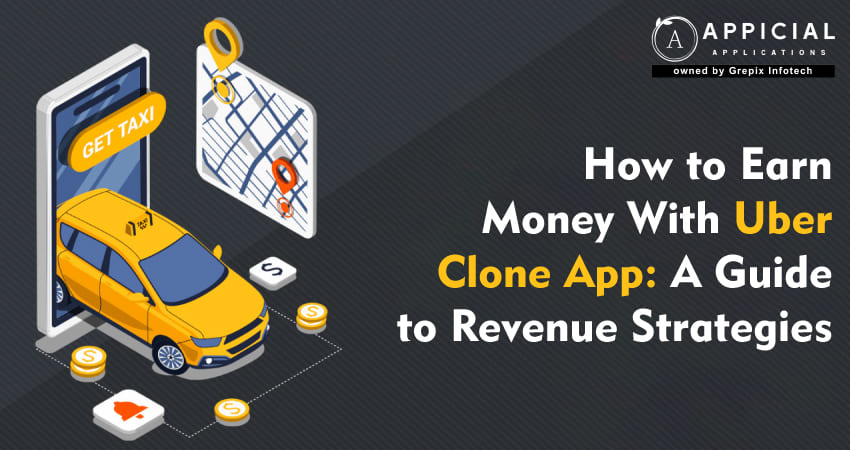
How to Earn Money With Uber Clone App: A Guide to Revenue Strategies
In today's fast-paced world, efficient transportation is not just a luxury but a fundamental need. Urban life depends heavily on seamless connectivity, and a taxi booking business plays a vital role in this ecosystem by providing both on-demand and scheduled rides. This business model is increasingly attractive to entrepreneurs because of its convenience, easy access, and rising popularity. As cities continue to grow and evolve, the demand for quick and reliable transportation solutions also increases, making the taxi booking industry a promising venture with substantial potential for profitability and growth. This opportunity is enhanced by the widespread acceptance and reliance on mobile technology, which facilitates access to such services for urban residents.
In the modern urban landscape, efficient transportation is essential, and the taxi booking business plays a crucial role in this dynamic. The industry's growth is propelled by the convenience and accessibility of services like Uber, which has set a benchmark for success through strategic market entry, innovative technology use, and expansive business models. Uber’s financial strategies, including diverse revenue streams from ride commissions to subscription services, have proven lucrative, with the ride-hailing market projected to reach $74.91 billion by 2027. The Uber Clone App offers entrepreneurs a streamlined path into this profitable market by mimicking Uber's successful features and functionalities, providing a cost-effective solution with ample opportunities for monetization. Strategies like in-app advertising, service fees, and surge pricing enhance revenue potential. Appicial supports this journey with its extensive experience developing on-demand applications, making the ride-hailing market more accessible and promising for new entrants aiming to replicate Uber’s success and sustainability.
The Rise of Uber: A Case Study in Success
Uber's dominance in the ride-hailing industry can be attributed to several strategic moves and innovations. Its early entry into the market provided a first-mover advantage while its effective utilization of technology and aggressive expansion tactics cemented its position as an industry leader.
The success of Uber, a pioneer in the ride-hailing industry, can be attributed to several key factors. Uber's timely market entry, innovative use of technology, and aggressive global expansion have solidified its position as a leader in the field. This success story provides a template for understanding the lucrative nature of the taxi booking business.
Revenue Streams: How Uber Makes Money
Uber's financial model is multifaceted and has evolved, enabling sustained growth. The primary revenue generator is its ride-hailing service, from which Uber takes a percentage of each fare as a commission. Additionally, Uber offers subscription services where customers pay a monthly fee for access to exclusive benefits. The company has also licensed its technology to other ride-hailing services, creating another source of income. Continuously exploring new business opportunities and partnerships has allowed Uber to expand its revenue streams effectively.
According to Statista, the ride-hailing industry is projected to reach a market size of $74.91 billion by 2027, with an average revenue per user (ARPU) of approximately $91.27. In the first quarter of 2023 alone, Uber's revenue increased by 29%, amounting to $8.8 billion, with over 300 million people using taxi apps for commuting. Uber’s financial strategy is multi-faceted, involving various revenue streams:
- Ride-Hailing Services: Uber earns a commission, taking a percentage of each fare.
- Subscription Services: Customers pay a monthly fee for additional benefits.
- Licensing Technology: Uber licenses its technology to other ride-hailing companies, generating income.
- New Ventures: Continuously exploring new opportunities and partnerships helps expand Uber’s revenue sources.
According to Statista, the ride-hailing industry is projected to reach $74.91 billion by 2027, with an expected Average Revenue Per User (ARPU) of $91.27. In 2023 alone, Uber’s revenue surged by 29% to $8.8 billion, indicating the vast potential of this market.
Understanding the Uber Clone App
An Uber Clone App is a ready-made solution for entrepreneurs aspiring to launch a taxi booking service. This clone includes the core functionalities and user experience of Uber’s platform, offering a cost-effective and time-efficient entry into the market. However, ensuring robust security features and adherence to local regulations is crucial due to the legal and security challenges inherent in the ride-hailing industry.
Monetizing an Uber Clone App
Navigating the competitive landscape of the ride-hailing industry requires a strategic approach to monetization, especially when deploying an Uber clone app. Here are proven strategies to generate revenue from your taxi booking platform. Investing in an Uber clone app offers multiple revenue-generating avenues:
- In-App Advertising: Leverage the app’s user base by showcasing targeted advertisements from local businesses. This approach provides a continuous revenue stream without detracting from the overall user experience.
- Booking and Service Fees: Implement a small fee for every booking made through the app. This fee might seem minimal, but as the app grows in popularity, these fees can substantially increase overall revenue.
- Ride Commissions: Collect a commission from each fare, which remains the primary revenue source for most ride-sharing platforms. This percentage-based system ensures that as the app's usage grows, so does its income.
- Surge Pricing: Introduce surge pricing during peak times to capitalize on high demand. While it can be a point of contention among users, it effectively maximizes earnings when the demand for rides exceeds the number of available drivers.
- Subscription Models: Offer tiered subscription plans that provide added value such as decreased wait times, lower fares, or free rides under certain conditions. It not only stabilizes revenue through recurring payments but also builds customer loyalty.
- Promotional Partnerships: Forge relationships with local businesses and service providers to include promotions within your app. It can attract more users while providing additional revenue from those partnerships.
These models not only enhance profitability but also ensure a diverse income stream for long-term sustainability. By integrating these strategies, your Uber clone app can tap into multiple revenue streams, enhancing profitability and ensuring long-term success in the bustling market of ride-sharing services.
Also Read: Want to Start a Taxi Booking Business? Let's Connect with Appicial Applications
Building Your Taxi Booking App
Leveraging an Uber clone can significantly reduce the cost and development time compared to building an app from scratch. If you are considering entering the ride-hailing market, a clone app provides a solid foundation with ample room for customization and scalability.
How Appicial Can Assist in Uber Clone App Development
As a leading mobile app development company in India, Appicial has extensive experience creating on-demand applications across various industries. With over 75 successful app launches worldwide, Appicial offers expertise in developing a robust and profitable Uber clone app. Whether it's technical challenges or strategic planning, Appicial is equipped to help you build a successful business in the competitive ride-hailing market.
By leveraging a clone app, the cost and time to develop an app similar to Uber are significantly reduced compared to building one from scratch. Appicial provides the necessary tools and guidance to not only create but also monetize an effective Uber clone app, helping entrepreneurs achieve their business objectives efficiently. For anyone looking to enter the taxi booking market, partnering with Appicial could be a strategic and cost-effective decision.
The taxi booking business model is not viable but thriving, driven by technological advancements and changing consumer behaviors. With the right approach and tools, such as the Uber Clone app, entrepreneurs can tap into this dynamic market to build a profitable and sustainable business.
Conclusion
In conclusion, the taxi booking business model, exemplified by the success of companies like Uber, presents a lucrative opportunity for entrepreneurs in today's fast-paced world. As urban populations continue to grow and the demand for efficient, reliable transportation increases, the market for ride-hailing services is set to expand even further. By leveraging an Uber Clone app, aspiring business owners can quickly and cost-effectively enter this dynamic industry, capitalizing on proven revenue models and advanced technology. With the right strategies in place, including robust monetization techniques and a focus on user experience, a taxi booking business can achieve significant profitability and long-term success. Partnering with experienced developers like Appicial ensures that your venture is built on a solid foundation, positioning your business to thrive in the competitive ride-hailing market.
Looking out to start your own venture like Uber? Try out our HireMe Taxi Uber Clone, the easiest way to kick-start your taxi business.




